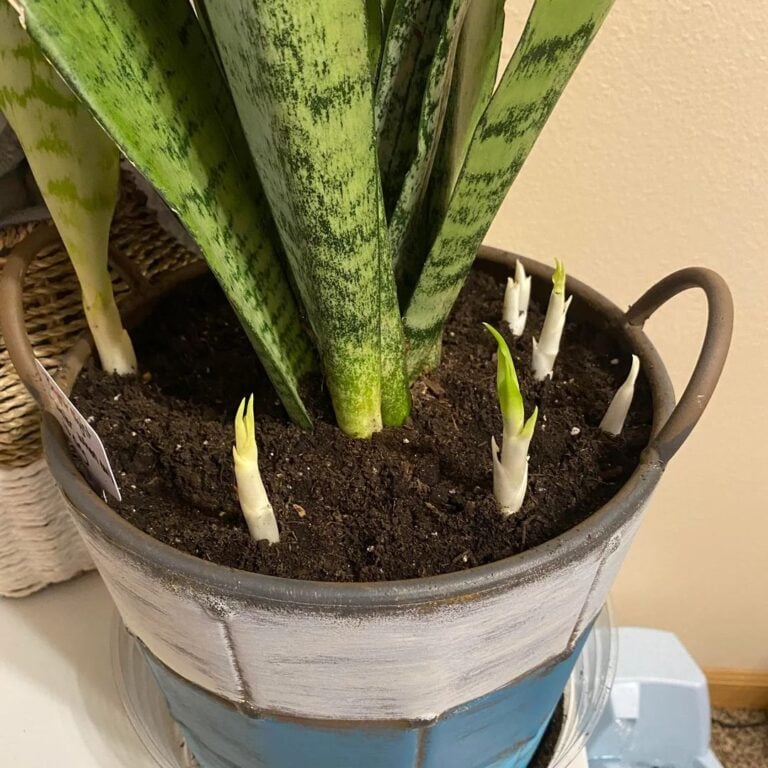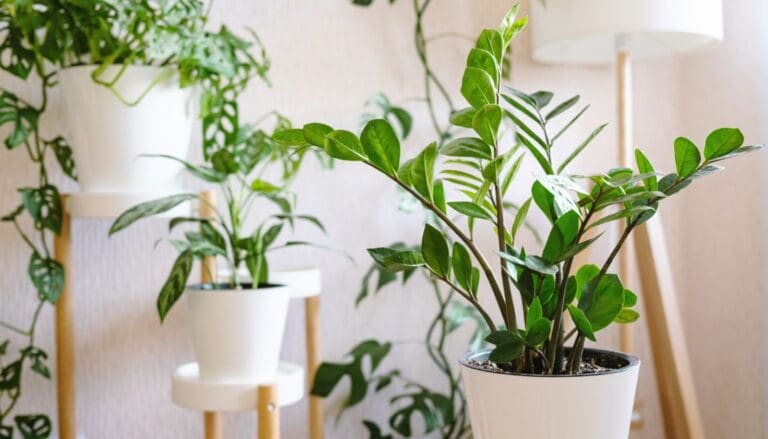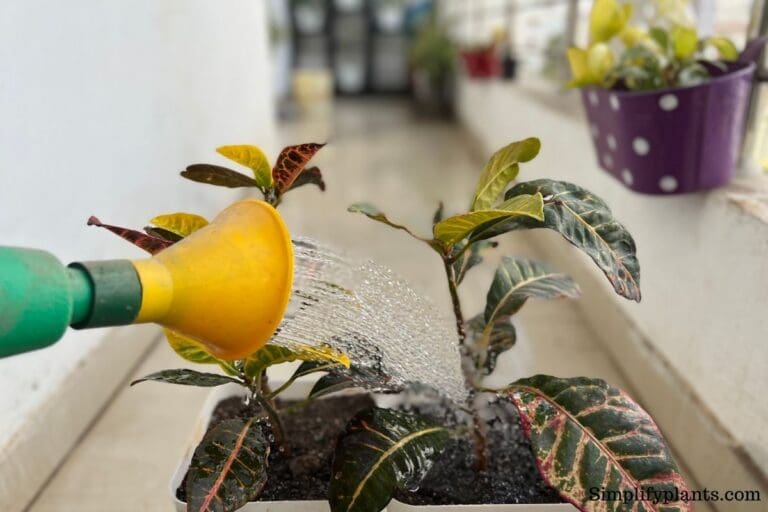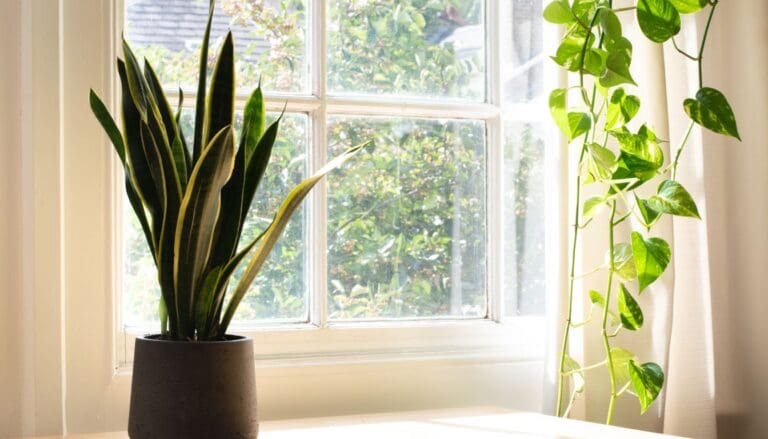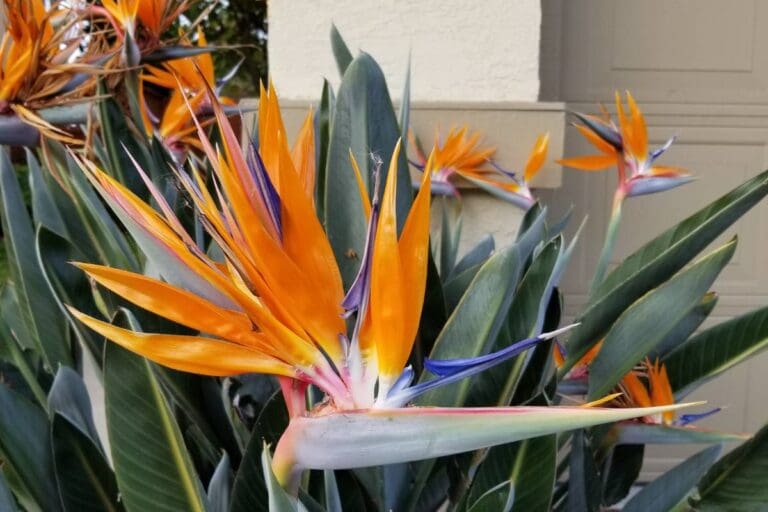10 Schefflera Plant Care Tips
Schefflera plants are graceful, elegant houseplants native to the tropical and sub-tropical regions of Taiwan and Australia. They can be grown with little care if you provide the plant with the right growing conditions.
Schefflera plant needs bright indirect sunlight and a loamy, well-draining soil mix. You must feed it during the growing season and grow it at a mild-moderate temperature while protecting it from harsh winters and scorching summers. This plant is prone to overwatering, so you must tweak the watering schedule as per the season.
To keep your Schefflera thriving and healthy, you must know the correct way to care for this plant. So in this guide, I will explain the basic care requirements for your umbrella plant.

Please note: Simplify Plants is reader-supported. Some links in the post are affiliate links and I get a commission from purchases made through links in the post.
How do I keep my Schefflera plant happy?
Schefflera is a hardy houseplant and does not require much care, but you must meet the basic requirements if you want the plant to grow well.
Check out the 10 basic care tips to make your Schefflera thrive.
1. Provide the Schefflera with indirect bright sunlight
In the natural habitat, Scheffleras grow under shades of bigger trees, so they only get the filtered sunlight.
Thus, they are meant to thrive where the harsh sunlight does not reach the leaves.
If the harsh sunlight falls on the leaves, the plant will show various signs of stress like sunburn, yellowing, browning, leaf curling, dehydration, and so on.
Therefore, you must remember to keep your umbrella plant in a spot where it will remain under shade.
If you take it outdoors, you can keep the plant on the shaded patio or a spot with the shade of bigger trees or buildings.
If you grow it as an indoor plant, you can keep it in an east-facing window or balcony where the sunlight is mild.

If you keep it on a south-facing balcony or window, put a curtain on the window during harsh summers to shield the light or keep it a few feet away from the window.
During summers, you can keep the plant near a bright north-facing window or balcony, with no harsh sunlight and relatively cooler than the other directions.
However, during winters, the plant will need warmth, so you can put it at an east-facing window so that it gets a few hours of mild morning sunlight.
Protecting it from harsh sunlight does not mean you can keep it in a low-light area.
If the lights are low, install artificial lights near the plant.
2. Keep the soil moist but not soggy
Being a tropical plant, Schefflera enjoys moisture and thrives in moist soil.
It is important to understand that moist soil is different from wet soil.
Schefflera is prone to overwatering and root rot, so you must never keep the soil wet for a prolonged period.
Wait until the top soil gets dry before watering the plant again.
Whenever the soil is no more sticking to your finger, you can water the plant.
Do not keep your plant dehydrated in bone-dry soil because that will cause the plant to dry up and droop.

Invest in a moisture meter if you are a beginner and find it difficult to understand the soil’s moisture content.
It is a device inserted in the soil to see how moist the soil is, and you can decide whether to water or wait until the soil is drier.
Another important factor to remember is to change the watering schedule with the season.
In summer, Schefflera would need more watering due to the intense heat and high evaporation.
However, it will need little water during fall and winter as the low light causes less evaporation in the plant.
So be careful during this period and always check the soil before watering.
If you overwater your plant, the soggy soil will block the oxygen and make it a breeding ground for pathogens and fungus, leading to root rot.
3. Use a loamy, well-draining, and slightly acidic soil
The soil is especially important for Schefflera’s health because it gets its necessary nutrients and food from the soil.
Unlike wild plants, potted plants are restricted within the pot and have no access to nutrients outside.
That is why you must understand the kind of soil this plant needs.
Schefflera requires soil that is very loose, sandy, and well-draining but at the same time can retain moisture for the plant.
The soil must be slightly acidic with a pH of 6.0-6.5.

Since Schefflera is prone to overwatering, the soil should be such that the excess water is all let out, and it still stays airy and loose.
It does not like compact clayey soil, which leads to suffocation in the roots due to a lack of airflow.
Here are 2 soil recipes that would be ideal for your Schefflera.
Recipe 1
- 30% potting soil
- 25% compost
- 25% peat moss
- 20% perlite
Recipe 2
- 2 parts potting soil
- 1 part perlite
- 1 part compost
While preparing the mix, add some crushed charcoal and pine bark to the soil to increase aeration.
4. Fertilize the Schefflera in the growing season
Fertilizers are added to the soil periodically to replenish it and add more nutrients which are gradually washed away due to regular watering.
Some plants are heavy feeders, some light feeders, and umbrella plants are medium feeders.
Hence over-fertilization and lack of fertilization both can affect it.
Without fertilization, the plant will not get sufficient nutrients, weakening it, losing its luster, and causing leggy growth.
On the other hand, overfertilization can lead to root burn and salt accumulation.
For Schefflera, the ideal time to fertilize is in the growing season.

You can fertilize it during March and September with a balanced 20-20-20 NPK fertilizer.
Do not ever fertilize it in the fall or winter because this is the period when the plant is dormant.
Hence fertilizers accumulate in the soil leading to burning in the roots.
Another point to remember is to always water the plant a day before fertilizing so it remains moist because fertilizing in dry soil can harm your plant.
5. Maintain high humidity
A distinct feature of tropical plants is their humidity requirement.
Schefflera plants thrive in a highly humid area and cannot tolerate dry air.
Humidity is one of the most important needs of this plant.
Schefflera needs at least 50% humidity to thrive, and anything lower than 40% can seriously affect their health.
If you are unsure about the humidity level around the home, get a hygrometer to measure it.
However, it is difficult to have high humidity levels inside our homes, which results in leaf curling, leaf dropping, yellowing drooping, and so on.
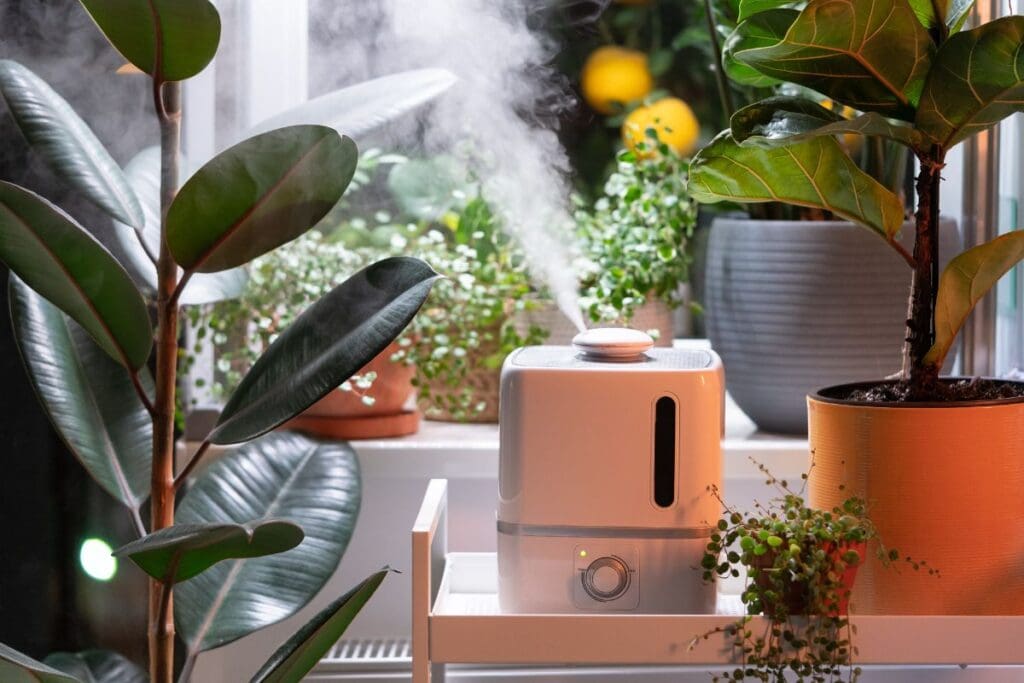
Luckily there are a few ways to increase humidity around your houseplants, which I will mention:
- Pebble trays: An easy and effective way to raise humidity is by putting a big tray filled with water and pebbles under your pot. As the water evaporates, the humidity level goes up around the plants.
- Misting: It is the most common way to give your plants a dash of humidity. However, its effects are not long-lasting because the water evaporates quickly. During scorching summers, you must mist the plants multiple times throughout the day but remember not to keep the leaves wet at night, which can invite pests.
- Humidifier: Installing humidifiers is the best and most effective way to raise the humidity around plants. Humidifiers are devices that need to be filled with distilled water and put near the plant.
- Grouping: Grouping the moisture-loving plants with Schefflera helps increase humidity levels. As the plants transpire, they give out moisture and increase the humidity.
- Aquarium: Placing a large aquarium near your Schefflera helps to raise the area’s humidity. This is because as the water from the aquarium evaporates, it gives out humidity.
- Relocation: Relocating the umbrella plant to a high humid area in the house is another way to increase humidity. Some examples are laundry room, bathroom, etc.
6. Maintain the correct temperatures
Schefflera grows in warm temperatures ranging from 65-90°F in nature.
They cannot tolerate very high scorching heat or harsh winters.
Their temperature requirements are moderately warm.
Anything below 50°F can be stressful for your plant.
And any above 90°F can dry out your plant, making it yellow, wilted, and dehydrated.
You can use the hygrometer to check the temperature around the plant.
If your umbrella plant gets struck by a frost, it can damage the plant, and you may lose it.
If you live in USDA zones 10-11, you can grow this plant outdoors all year.
However, if you live north of it, bringing the plant indoors during winters is highly recommended to keep it warm.
But do not keep the plant near fireplaces or heaters to give them warmth because that will absorb the moisture from the plant, stressing them out more due to the fluctuation in temperature.
You can keep the plant a few feet away from the heating source.
Avoid keeping the plant near frosted windows or vents where cold air can stress the plant.
7. Prune your umbrella plant to encourage growth

Pruning our umbrella plant is an important step that we tend to ignore.
Pruning removes dead parts and encourages more growth by stimulating the hormones.
Without pruning, the plant grows leggy and thin and lacks volume and new growth.
Remember, the yellow parts will not turn green even after the problem is fixed, so it is best to remove those leaves.
The parts of your plant which you should prune are:
- Dead yellow-brown leaves
- Yellowed or brown branches and stems
- Dried flowers
- Leggy growth or stems which have become thin and bent
Always prune with a sterilized pruner to avoid pest infestations or diseases.
If you do heavy pruning, do that only in the growing seasons.
During winters, do not prune heavily.
Just trim off the dead parts to help the plants store their energy.
8. Repot your Schefflera only when required
Repotting is an essential care requirement of all houseplants.
When the umbrella plant grows too big for the existing pot, you must repot it in a bigger pot.
Schefflera is a medium-growing plant, so it is recommended to repot it every 3-4 years.
However, if your plant catches a root disease, you must repot it immediately to save it.
Repotting causes a lot of stress and shock to plants, which is why you should only do it if needed.
Also, the soil gradually gets exhausted with daily watering, and only fertilizing does not help.
It is recommended to repot the plant with a fresh soil mix and nutrients.

Let us discuss the benefits of repotting:
- It gives the root-bound plant more space to spread its root
- It gets rid of the dead roots and leaves.
- Fresh soil gives the plant a boost to encourage growth
- If the plant gets too crowded, repotting helps clear and propagate them in separate pots.
While repotting, do not choose a pot that is more than two inches bigger than the pot.
An excessively big pot may lead to overwatering problems by holding too much water.
While repotting, trim off all the dead parts of the plant with sterilized pruners to encourage new and fresh growth.
9. Prevent pest infestations
Pest infestations are a serious concern, and sometimes despite providing all the necessary care, the bugs still attack the plants.
Pest infestations happen mostly due to wrong growing conditions around the plant.
Bugs like scales and mealybugs attack plants that grow in wet soil.
Too much humidity invites these plants, whereas spider mites appear due to dry air and dusty leaves.
These bugs mostly also attack in areas where there is not enough ventilation.
And these bugs spread from one plant to another in no time, so it is extremely important to separate your plant from the others the moment you notice any pest infestation.

Let us read what to do if any bugs attack your plant:
- Wash your Schefflera under running water thoroughly, focusing o the areas where bugs are attached.
- Then keep the plant at a spot with ample bright light and airflow, so the water evaporates quickly.
- After that, examine the plant thoroughly to find if there are more bugs. If so, trim off those parts.
- Then prepare a Neem oil solution and spray it generously throughout the plant.
- Let it marinate the plant, and do not wash it off.
- Repeat it 2-3 times every week until you see all the pests cleared.
- However, if you see the pests refusing to clear off, use pesticides and spray them over the plant.
Along with clearing away the bugs, ensure you fix the growing conditions around your plant.
Let us quickly learn the ways to keep your plant clean and bug-free:
- Too much humidity and dampness are common reasons for bugs to attack. So water your plant only when the top soil is dry.
- Make sure your Schefflera gets enough bright light and airflow. Keep them in a well-ventilated place.
- Keep the leaves of your umbrella plant clean. Wipe them weekly to keep them dust-free. It keeps away bugs and improves the plant’s capacity to photosynthesize.
- Neem oil can be an excellent organic pesticide to prevent pest infestations. You can spray your plant with Neem oil periodically to keep it clean and repel all bugs.
10. You can propagate your Schefflera to get more plants
Propagating is the technique of getting new plants from the existing plant by getting cuttings or dividing.
Propagation helps to get more plants without spending money to buy new ones.
Schefflera can be propagated through cuttings and seeds, which is a more difficult method.
You can propagate Schefflera stem cuttings in both water and soil.

Let us read about the process of propagating the plant:
- Choose a healthy stem to get a cutting. Make sure the stem is mature and healthy with 3-4 leaves on it.
- Before cutting, sterilize your sharp pruning shears and make a sharp, clean cut.
- Put that cutting in a glass of clean water or a loose well-draining soil mix.
- In the case of water, propagation changes the water every 3-4 days to avoid algae or bacteria growth in the water.
- If you are propagating the plant in soil, ensure you keep the soil slightly moist at all times.
- The roots take around 1-2 months to appear, and once the roots get a little stronger and bigger, you can repot the cuttings to a fresh new soil mix.
Some more tips for a happy Schefflera
Now that we have understood your Schefflera’s basic and most important requirements let us take a look at a few extra tips for a happy plant.
- Do not let your pets or children play with this plant as its sap contains toxic calcium oxalate crystals that, if ingested, can lead to complications.
- Keep the leaves of your plant by wiping them regularly. Clean leaves prevent pest attacks and improve photosynthesis.
- Rotate the plant weekly, so it does not bend on one side in search of light.
- Spray Neem oil monthly to keep the plant pest-free.
- Do not repot or change its position frequently unless needed.
Final words
Schefflera are low-maintenance plants that you can grow in your homes and offices. You only need to provide it with the correct growing conditions.
Remember to provide lots of light and humidity, water per requirement, and feed the plant during the growing period. Prune off the dead parts to keep the plant clean and repot with fresh soil every few years.
Recommended Garden Supplies
| Product Image | Our Recommended Gardening Supplies | Check Offers! |
|---|---|---|
Top Top
Top
Top
Top
Top
Top
Top
Top | rePotme Houseplant and Tropical Classic Potting Soil Mix | Check Offer On Amazon |
 Top
Top
Top
Top
Top
Top
Top
Top | Espoma Organic Indoor Plant Food | Check Offer On Amazon |
 Top
Top
Top
Top
Top
Top
Top
Top | GooingTop LED Grow Light 6000K Full Spectrum Clip Plant Growing Lamp | Check Offer On Amazon |
 Top
Top
Top
Top
Top
Top
Top
Top | Soil Moisture Meter | Check Offer On Amazon |
 Top
Top
Top
Top
Top
Top
Top
Top | Govee Hygrometer Thermometer, Bluetooth Enabled! | Check Offer On Amazon |
 Top
Top | LEVOIT Humidifiers for Large Room(Best For Plants) | Check Offer On Amazon |
 Top
Top
Top
Top
Top
Top
Top
Top | Upgraded DIY Automatic Drip Irrigation Kit, 15 Potted Houseplants Support | Check Offer On Amazon |
 Top
Top
Top
Top
Top
Top
Top
Top | Stainless Steel Heavy Duty Gardening Tool Set | Check Offer On Amazon |
 Top
Top
Top
Top
Top
Top
Top
Top | Bonide Insecticidal Soap | Check Offer On Amazon |
 Top
Top
Top
Top
Top
Top
Top
Top | Bonide 32 oz Spray Neem Oil for Organic Gardening | Check Offer On Amazon |
 Top
Top
Top
Top
Top
Top
Top
Top | Garden Safe Fungicide | Check Offer On Amazon |

